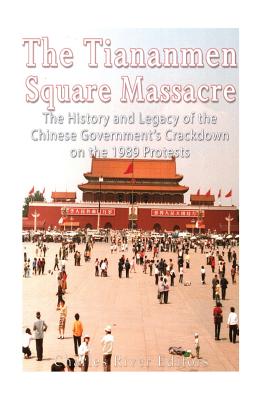The Tiananmen Square Massacre: The History and Legacy of the Chinese Government's Crackdown on the 1989 Protests

The Tiananmen Square Massacre: The History and Legacy of the Chinese Government's Crackdown on the 1989 Protests
*Includes accounts of the protests
*Includes online resources and a bibliography for further reading
"Students, we came too late. We are sorry. You talk about us, criticize us, it is all necessary. The reason that I came here is not to ask you to forgive us. All I want to say is that students are getting very weak, it is the 7th day since you went on hunger strike, you can't continue like this. [...] You are still young, there are still many days yet to come, you must live healthy, and see the day when China accomplishes the four modernizations. You are not like us, we are already old, it doesn't matter to us any more." - Zhao Ziyang at Tiananmen Square. May 19, 1989.
On June 5, 1989, a petrifying procession of Type 59 tanks with bright red stars emblazoned on the sides rolled down the eerily vacant streets of Chang'an Avenue, headed towards Tiananmen Square. Photographer Jeff Widener, along with the disorderly rabble of the media, public, and protesters, watched with bated breath, some from the sidelines, and some from the windows of buildings and nearby establishments.
Suddenly, the buzz of panic turned into a chorus of disbelieving gasps. A man by his lonesome, dressed in a white cotton blouse and a pair of black slacks, casually strolled into the street, 2 shopping bags swinging in hand. Some were bewildered by the thought of the man foolishly attempting to cross the road at the worst possible time, but when this man deliberately stopped in the path of the tanks, there was a beat of stunned silence. The man, perhaps unaware of the thousands of eyes fixated on him, coolly stared down the tanks as their treads slowly grinded to a halt, one at a time.
This iconic scene captured by Widener, dubbed the "Tank Man," has become one of the most widely recognizable photographs from the 20th century, an image that springs to mind at the mention of the infamous Tiananmen Square Incident of 1989. The Tank Man would become one of the most defining symbols of the cause - defiance against what the people deemed an oppressive higher power, shored up by the iron wills of this unidentified man and millions like him.
That said, there is always far more than meets the eye - or the ear. Take Widener's photograph itself as just one example. Tank Man can be seen in front of 4 tanks, an image stirring enough on its own. Yet in another photographer's image, which shows a wider, almost bird's eye view of the scene, audiences
PRP: 77.42 Lei
Acesta este Prețul Recomandat de Producător. Prețul de vânzare al produsului este afișat mai jos.
61.94Lei
61.94Lei
77.42 LeiIndisponibil
Descrierea produsului
*Includes accounts of the protests
*Includes online resources and a bibliography for further reading
"Students, we came too late. We are sorry. You talk about us, criticize us, it is all necessary. The reason that I came here is not to ask you to forgive us. All I want to say is that students are getting very weak, it is the 7th day since you went on hunger strike, you can't continue like this. [...] You are still young, there are still many days yet to come, you must live healthy, and see the day when China accomplishes the four modernizations. You are not like us, we are already old, it doesn't matter to us any more." - Zhao Ziyang at Tiananmen Square. May 19, 1989.
On June 5, 1989, a petrifying procession of Type 59 tanks with bright red stars emblazoned on the sides rolled down the eerily vacant streets of Chang'an Avenue, headed towards Tiananmen Square. Photographer Jeff Widener, along with the disorderly rabble of the media, public, and protesters, watched with bated breath, some from the sidelines, and some from the windows of buildings and nearby establishments.
Suddenly, the buzz of panic turned into a chorus of disbelieving gasps. A man by his lonesome, dressed in a white cotton blouse and a pair of black slacks, casually strolled into the street, 2 shopping bags swinging in hand. Some were bewildered by the thought of the man foolishly attempting to cross the road at the worst possible time, but when this man deliberately stopped in the path of the tanks, there was a beat of stunned silence. The man, perhaps unaware of the thousands of eyes fixated on him, coolly stared down the tanks as their treads slowly grinded to a halt, one at a time.
This iconic scene captured by Widener, dubbed the "Tank Man," has become one of the most widely recognizable photographs from the 20th century, an image that springs to mind at the mention of the infamous Tiananmen Square Incident of 1989. The Tank Man would become one of the most defining symbols of the cause - defiance against what the people deemed an oppressive higher power, shored up by the iron wills of this unidentified man and millions like him.
That said, there is always far more than meets the eye - or the ear. Take Widener's photograph itself as just one example. Tank Man can be seen in front of 4 tanks, an image stirring enough on its own. Yet in another photographer's image, which shows a wider, almost bird's eye view of the scene, audiences
Detaliile produsului









